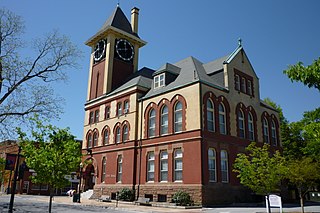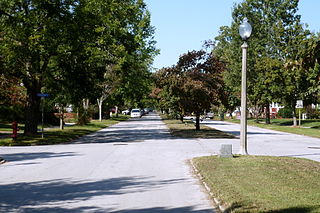
New Bern is a city in Craven County, North Carolina, United States. As of the 2010 census it had a population of 29,524, which had risen to an estimated 29,994 as of 2019. It is the county seat of Craven County and the principal city of the New Bern Metropolitan Statistical Area.

Green Level is an unincorporated community near the town of Cary in southwestern Wake County, North Carolina, United States. It was founded around 1800, and is one of the oldest surviving crossroads communities in the Raleigh area.

Dix Hill is the informal name for a high, rolling expanse of land and national historic district located at Raleigh, North Carolina. The district encompasses 18 contributing buildings, 1 contributing site, and 3 contributing structures. It includes notable examples of Colonial Revival, Bungalow / American Craftsman, and Stick Style / Eastlake Movement architecture. The Dorothea Dix Hospital, a historic institution caring for the mentally ill, was located on the site. The hospital buildings were developed between about 1856 and 1940.

The Cedarock Historical Farm, located at Cedarock Park in Alamance County, North Carolina, provides an example of life on a farm in North Carolina during the 19th Century. Populated with farm animals, antique and replica farm equipment, and a farmhouse, the Historical Farm provides a fun, education stop while visiting Cedarock Park.

The Capitol Area Historic District is a national historic district located at Raleigh, North Carolina. The district encompasses 25 contributing buildings and was developed after 1792. The district includes notable examples of Classical Revival and Late Gothic Revival style architecture. Located in the district are the following separately listed buildings:

Aspen Hall is a historic plantation house located near Pittsboro, Chatham County, North Carolina. The original section was built in the 1790s, and took its present form between about 1830 and 1840. It is a two-story, weatherboarded gable roofed Federal style frame house, with a Greek Revival style facade. It was built by Joseph John "Chatham Jack" Alston, who also built the nearby Alston-DeGraffenried Plantation.

Ghent Historic District is a national historic district located at New Bern, Craven County, North Carolina. It encompasses 191 contributing buildings developed as a suburban residential neighborhood in New Bern between 1912 and 1941. The district is characterized by dwellings in the Colonial Revival and Bungalow / American Craftsman styles.

Alston-DeGraffenried Plantation or Alston-DeGraffenried House is a historic property located in Chatham County, North Carolina, near Pittsboro, North Carolina. It includes a plantation house built through the forced labor of at least 11 enslaved people between about 1810 and 1825, and its surrounding agricultural fields. The property was first listed on the National Register of Historic Places in 1974 and the listed area was increased in 1993. The house and the surrounding land are identified as a national historic district.

The United States Post Office and Courthouse is a courthouse of the United States District Court for the Eastern District of North Carolina, located in New Bern, North Carolina. The building was completed in 1935, and was listed in the National Register of Historic Places in 1973, as a contributing building within the New Bern Historic District, and was individually listed in 2018.

Rue Chapel AME Church is a historic African Methodist Episcopal church located at 709 Oak Street in New Bern, Craven County, North Carolina. It was built in 1941, and is a rectangular brick church building in the Late Gothic Revival style. It features a gabled nave flanked by corner entrance towers. Also on the property is the contributing parsonage; a one-story, front-gable brick house of the American Craftsman style dated to the 1920s.

St. Peter's AME Zion Church is a historic African Methodist Episcopal church located at 615 Queen Street in New Bern, Craven County, North Carolina. It was built between 1923 and 1942, on the site of the 1914 church building which was destroyed by fire in 1922. It is a large three bay by seven bay, rectangular brick church building in the Late Gothic Revival style. It features a gabled nave flanked by two-story truncated stair towers. Also on the property is the contributing 1926 parsonage; a 2 1/2-story, frame American Craftsman style dwelling. It is known within the denomination as the "Mother Church of Zion Methodism in the South," and the oldest existing African Methodist Episcopal congregation in the South.

The Roanoke Park Historic District a national historic district located at Raleigh, North Carolina. It is one of the city's historic Five Points neighborhoods and encompasses 446 contributing buildings and 1 contributing site. It is situated southeast of the Five Points intersection of Glenwood Avenue and Fairview and Whitaker Mill Roads. Roanoke Park is composed of six separate plats, filed from 1913 to 1926, and is roughly shaped like a diamond.

The New Bern Historic District is a national historic district located at New Bern, Craven County, North Carolina. As of 2003 the district contained 492 contributing structures with construction dates ranging from the early 1800s to the mid-20th century. The district contains notable examples of buildings in the Federal and Late Victorian styles.

Proximity Park Historic District is a national historic district located at Asheville, Buncombe County, North Carolina. The district encompasses 62 contributing buildings and 1 contributing site in a predominantly residential section of Asheville. The district was largely developed in early-20th century, and includes representative examples of Colonial Revival, Mission Revival, and Bungalow style dwellings. Located in the district is the separately listed St. Mary's Church (1914) and rectory (1923) designed by architect Richard Sharp Smith.

Riverside Historic District is a national historic district located at New Bern, Craven County, North Carolina. It encompasses 101 contributing buildings and 4 contributing sites developed as a suburban residential neighborhood in New Bern between 1894 and 1921. The district is characterized by dwellings in the Classical Revival, Queen Anne, and Bungalow / American Craftsman styles. Notable non-residential buildings include the Riverside Graded School, Riverside United Methodist Church, S. B. Parker Company Building, Sadler's store, and Hawkins Grocery Store.

Fisher Park Historic District is a national historic district in the Fisher Park neighborhood, Greensboro, Guilford County, North Carolina. The district encompasses 541 contributing buildings, 2 contributing sites, and 44 contributing structures in a predominantly residential section of Greensboro. The houses were largely built between the 1900s and 1930s and include notable examples of Queen Anne, Colonial Revival, Gothic Revival, American Foursquare, and Bungalow / American Craftsman-style architecture. Located in the district are the separately listed Dixon-Leftwich-Murphy House, John Marion Galloway House, Julian Price House, and Latham-Baker House. Other notable buildings include the First Presbyterian Church (1928), Holy Trinity Episcopal Church (1922), Gant-McAlister House, and A.J. Schlosser House.

Irving Park Historic District is a national historic district located at Greensboro, Guilford County, North Carolina. The district encompasses 164 contributing buildings, 5 contributing sites, 2 contributing structures, and 2 contributing objects in an affluent planned suburb of Greensboro. It developed around the Greensboro Country Club. The houses were largely built between 1911 and the 1930s and include notable examples of Colonial Revival, Tudor Revival, and Classical Revival-style architecture. Notable buildings include the first Robert Jesse Mebane House, the Cummins A. Mebane House, the Lynn Williamson House, the first J. Spencer Love House, the Aubrey L. Brooks House, Carl I. Carlson House, the Van Wyck Williams House, the Lavlson L. Simmons House, the Albert J. Klutz House, the Irving Park Manor Apartments, McAdoo-Sanders-Tatum House, the Alfred M. Scales House, and the Herman Cone House.

Carolina Heights Historic District is a national historic district located at Wilmington, New Hanover County, North Carolina. The district encompasses 421 contributing buildings, 1 contributing site, and 1 contributing object in a predominantly residential section of Wilmington. The district developed as planned suburban areas between about 1908 and 1950 and includes notable examples of Queen Anne, Classical Revival, Colonial Revival, and Bungalow / American Craftsman style architecture. Notable buildings include the New Hanover High School (1922), the Trinity Methodist Episcopal Church (1921), St. Paul's Episcopal Church (1927/1956-1958), First Church of Christ, Scientist (1928), Sinclair Service Station, and Yopp Funeral Home (1936).

Seaboard Historic District is a national historic district located at Seaboard, Northampton County, North Carolina. The district encompasses 107 contributing buildings, 1 contributing site, and 4 contributing structures in the central business district and surrounding residential sections of Seaboard. The district developed between about 1874 and 1955 and includes notable examples of Queen Anne and Colonial Revival style architecture. Notable contributing resources include the Edwards Warehouse, Bradley Howell Peanut Drying and Storage Facility, Sidney S. Harris Gas Station, Stephenson-Barbee House, Edwards House, Seaboard United Methodist Church, Bethlehem Baptist Church, and Seaboard School (1927).

Valle Crucis Historic District is a national historic district located at Valle Crucis, Watauga County, North Carolina. The district encompasses 50 contributing buildings, 1 contributing site, and 7 contributing structures in the central business district and surrounding residential sections of Valle Crucis. It developed between about 1812 and 1954, and includes notable examples of Gothic Revival, Bungalow / American Craftsman, and Colonial Revival style architecture. Located in the district are the separately listed Mast General Store, Mast Farm, and Valle Crucis Episcopal Mission. Other notable contributing buildings are the Baird Farm, Lucy Mast Olsen House (1936-1940), Taylor tobacco barn, Farthing Store (1909), Valle Crucis Bank (1914), Hard Taylor House, and C. D. "Squire" Taylor House (1911).





















